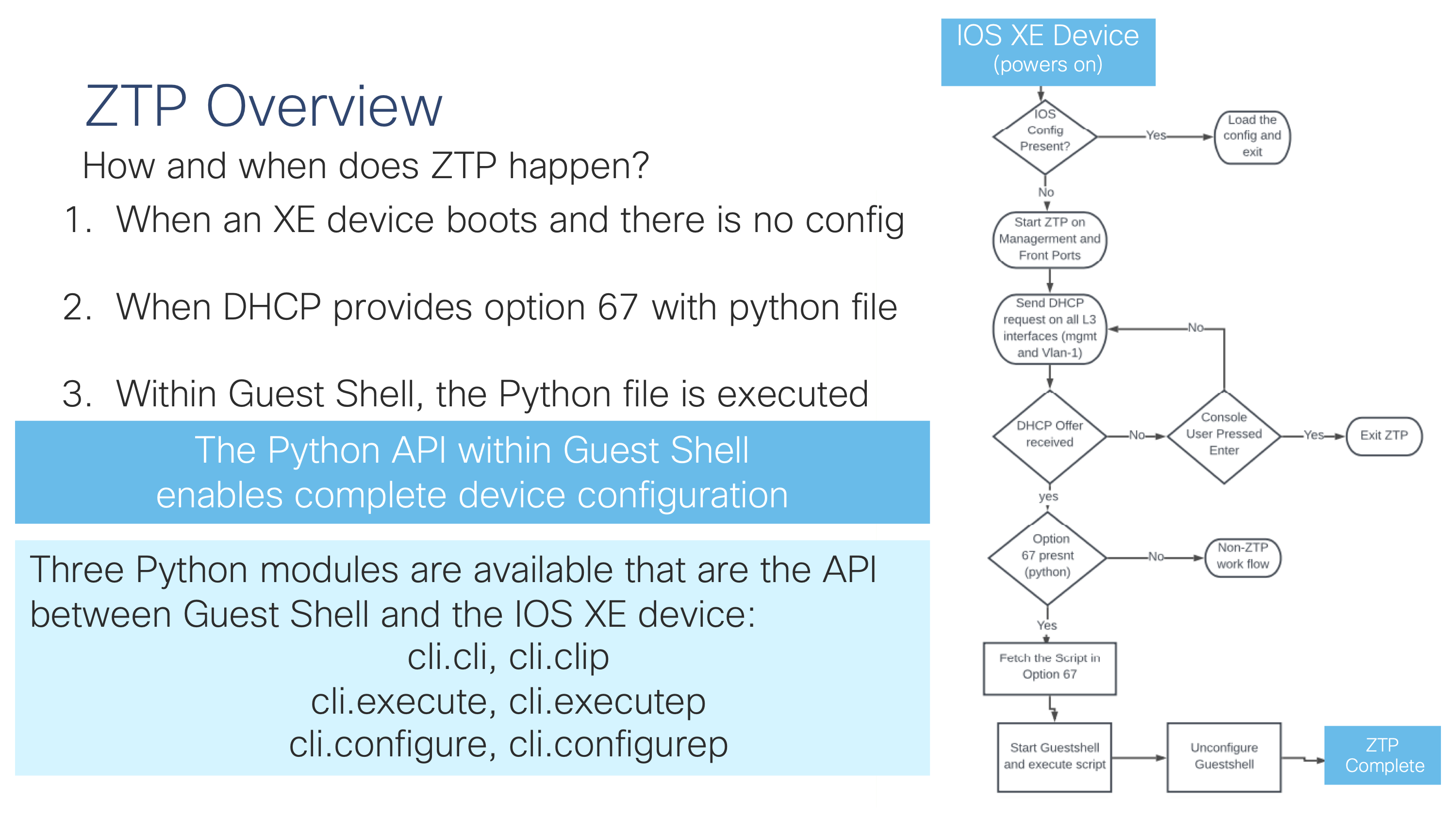The Zero Touch Provision solution fits within the Day 0 - Device Onboarding part of the IOS XE device lifecycle. It's function is to onboard network devices to the network. There are components from Day N - Device Optimzation specifically the Python API and the Gueset Shell Linux Container that are leveraged as part of the ZTP feature. There are other labs that focus more on Guest Shell and the Python API, as well as on the Day 1 and Day 2 features that are not covered as part of this lab.
Zero Touch Provision, or ZTP, is part of the Day 0 device programmability ecosystem which enables network operators to provision network device more programmatically. Using a combiation of DHCP, Python, and the Linux Guest Shell container, the ZTP feature is used to fully configure the device automatically during it's initial boot.
When a device that supports Zero-Touch Provisioning boots up, and does not find the startup configuration (during initial installation), the device enters the Zero-Touch Provisioning mode.
The device searches for an IP from a DHCP server and bootstraps itself by enabling the Guest Shell Linux container. The device then obtains the IP address or URL of the HTTP or TFTP server, and downloads a Python script from the server to configure the device.
- A DHCP server with option 67 specifying the Python file
- Webserver or TFTP server to provide the Python file
- The Python file for ZTP
A DHCP server is required for ZTP, as this is how the device learns about where to find the Python configuration file from. In this case, the DHCP server is the open source ISC DHCPd and the configuration file is at /etc/dhcp/dhcpd.conf in the Linux developer box. The option bootfile-name is also known as option 67 and it specifies the configuration file is ztp.py
- Enable DHCP Server
- Configure option 67
- Restart DHCP server
cat /etc/dhcp/dhcpd.conf | grep bootfile-name
# Example for DHCP Option 67 bootfile-name with HTTP:
option bootfile-name "http://192.168.69.1/ztp.py";
ps xa |grep dhcpd
tail -F /var/log/dhcpd.log &In the above example the Python file for ZTP is called ztp.py and is hosted at the webserver root directory which is set within the Apache webserver configuration.
ZTP accesses the python configuration file from HTTP or TFTP. In the example HTTP is used.
ps xa | grep httpd
tail -F /var/log/httpd/access_log &
The ZTP.py file is located in the websrver root directory at /var/www/html/ and is downloaded by the IOS XE device during the ZTP workflow.
cat /var/www/html/ztp.py
print "\n\n *** Sample ZTP Day0 Python Script *** \n\n"
# Importing cli module
import cli
print "Configure vlan interface, gateway, aaa, and enable netconf-yang\n\n"
cli.configurep(["int vlan 1", "ip address 10.5.123.27 255.255.255.0", "no shut", "end"])
Included in the repository are several example ZTP.py files. From basic example with just a few CLI's to an advanced use case where model number and serial numbers are evaluated as variables.
- ztp-simple.py - Simple ZTP file to provision the IP and AAA and enable the API
- ztp-debug.py - Debug commands for additional output and troubleshooting
- ztp-advanced.py - Avanced use case where the software is upgraded and configuration file is applied
- Reserve the ZTP sandbox
- Review the ZTP Learning Lab
- Demo recording available on YouTube

